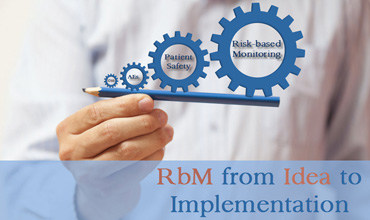The Evolving Role of the Clinical Study Monitor and Study Team Members in the Age of Risk Based Monitoring (RBM)

Abstract:
A Risk Based Approach to Monitoring (RBM) guidance
released by the EMA and FDA has generated tremendous opportunities and
discussions on the prospects of clinical trial monitoring practices. This
guidance has raised an array of new tools, technologies and systems to
facilitate the approach. However, there is very limited information on the how
the clinical trial professionals will have to adapt and adopt their behaviors,
skills, competencies and knowledge to leverage the optimal outcome. This paper
via literature search and dialogue sessions explores the current working
practices and illustrates the evolving role of a clinical trial monitor and key
study team members in the RBM landscape. The current working practices suggest
that RBM is creating interdependencies between the cross functional team
members. This interdependency and appropriate leveraging of the competencies
between the study team members is a key component to driving the culture shift
towards a more in-stream data visualization, review and quality governance.
KEYWORDS
Risk Based Monitoring, Clinical Trial Monitoring,
Clinical Trial Monitor and Quality Governance
References:
1. Clinical Trials Transformation Initiative (CTTI).
(2012). Effective and efficient
monitoring as a component of quality. Retrieved from CTTI website on July
7, 2014: http://www.ctti-clinicaltrials.org/briefing-room/official-recommendations#Monitoring_Rec
2.
Cognizant. (2012). Risk-Based
Monitoring Strategies for Improved Clinical Trial Performance. Retrieved on
Oct 3, 2014 http://www.cognizant.com/InsightsWhitepapers/Risk-based-Monitoring-Strategies-for-Improved-Clinical-Trial-Performance.pdf
3.
European
Medicines Agency (EMA). (2013). Reflection
paper on risk based quality management in clinical trials. Retrieved from EMA website on July 29, 2014: http://www.ema.europa.eu/docs/en_GB/document_library/Scientific_guideline/2013/11/WC500155491.pdf
4.
Food
and Drug Administration, E6 Good Clinical Practice. (1996). Consolidated guidance for the industry. Retrieved from Food and Drug
Administration website on Oct 2, 2014: http://www.fda.gov/downloads/Drugs/Guidances/ucm073122.pdf
5.
Food
and Drug Administration. Guidance for
Industry. (2013). Oversight of Clinical
Investigations, A Risk-Based Approach to Monitoring. Retrieved from Food and Drug Administration
website on July 7, 2014:http://www.fda.gov/downloads/Drugs/.../Guidances/UCM269919.pdf
6. Kumar P; Dalal,
J; Jadhav. (2014). Risk Based Monitoring-Current Challenges with
Implementation. Postdoc Journal,
Vol.2, No.11, November 2014.
7.
Morrison
B, Cochran C, Giangrande J, et al. (2011). Monitoring the Quality of Conduct of
Clinical Trials: A Survey of Current Practices. Clinical Trials, 8:342–349
8.
Pharmaceutical
and Food Safety Bureau (PFSB). (2014). Basic Rules of the Risk-Based Approach
to Monitoring Clinical Trials. Retrieved from Google on October 10, 2014: http://www.dmbasso.org/wpcontent/uploads/2014/02/JapanGuidanceforRBMJuly2013.pdf
9.
Quintiles. (2014). The
Role of Data Management in Risk-Based Monitoring: A Critical Element in Data-driven Trials. August 2014. Retrieved from YouTube on July 22, 2014: http://www.youtube.com/watch?v=SsDQ952rSBw
10. Stokols D, Hall KL,
Taylor BK, Moser RP. (2008). The
science of team science: overview of the field and introduction to the
supplement. Am J Prev Med 35 (2 Suppl): S77–89. Doi: 10.1016/j.amepre.2008.05.002. PMID 18619407
11. TransCelerate Biopharma Inc. (2012).
Position Paper: Risk-Based Monitoring Methodology. Retrieved from TransCelerate Biopharma website on July 7, 2014. http://www.transceleratebiopharmainc.com/rbm-resources/

